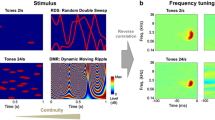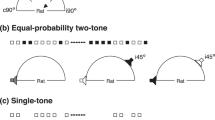Summary
Amplitude modulation at the receiver's ears is a characteristic of moving sound sources. When a sound source moves from side to side, stimulus intensity decreases in one ear and increases in the other. When a sound source moves toward or away from the organism, the two ears receive correlated increases or decreases in sound level. We recorded from single cells in the auditory cortex while presenting amplitude modulated pure tones to the two ears which simulated motion either toward or away from the organism, or from side to side. Our results indicate that auditory cortex neurons can be highly sensitive to these correlates of auditory motion in three dimensional space. Three major classes of neurons were encountered. These included 1) neurons sensitive to azimuthal stimulus motion, 2) neurons sensitive to motion directly toward or away from the organism, and 3) monaural-like neurons. More toward-preferring neurons than away-preferring neurons were encountered, and more units preferred contralateral-directed than ipsilateral-directed movement. The different classes of direction-selective neurons were spatially segregated from each other within the cortex and appear to occur in columns. In addition to their selectivity for different directions of simulated sound source motion, auditory cortex neurons could also be highly selective to AM ramp rate and excursion; these are correlates of sound source velocity.
Similar content being viewed by others
References
Altman JA (1987) Information processing concerning moving sound sources in the auditory centers and its utilization by brain integrative and motor structures. In: Syka J, Masterton RB (eds) Auditory pathway: structure and function. Plenum Press, New York, pp 349–354
Beverley KI, Regan D (1973) Evidence for the existence of neural mechanisms selectively sensitive to the direction of movement in space. J Physiol 235:17–29
Cynader M, Regan D (1978) Neurons in cat parastriate cortex sensitive to the direction of motion in three-dimensional space. J Physiol 274:549–569
Eisenman LM (1974) Neural encoding of sound location: an electrophysiological study in auditory cortex of the cat using free field stimuli. Brain Res 75:203–214
Gardner M (1968) Distance estimation of 0° or apparent 0°-oriented speech signals in anechoic space. J Acoust Soc Am 45:47–53
Gourevitch G (1978) Directional hearing in mammals. In: Popper AN, Fay RR (eds) Comparative studies of hearing in vertebrates. Springer-Verlag, New York, pp 357–373
Jenkins WM, Masterton RB (1982) Sound localization: effects of unilateral lesions in central auditory system. J Neurophysiol 47:987–1016
Jenkins WM, Merzenich MM (1984) Role of cat primary auditory cortex for sound-localization behavior. J Neurophysiol 52:819–847
Kitzes LM, Wrege KS, Cassady JM (1980) Patterns of responses of cortical cells to binaural stimulation. J Comp Neurol 192:455–472
Mendelson JR, Cynader MS (1983) Frequency disparity selectivity in cat primary auditory cortex (A1). Soc Neurosci Abs V9:955
Mershon D, King L (1975) Intensity and reverberation as factors in the auditory perception of egocentric distance. Perception and Psychophysics 18:409–415
Middlebrooks JC, Pettigrew JD (1981) Functional classes of neurons in primary auditory cortex of the cat distinguished by sensitivity to sound source location. J Neurosci 1:107–120
Perrott DR, Marlborough K (1989) Minimum audible movement angle: marking the end points of the path travelled by a moving sound source. J Acoust Soc Am 85:1773–1775
Reale RA, Kettner RE (1986) Topography of binaural organization in primary auditory cortex of the cat: effects of changing interaural intensity. J Neurophysiol 56:663–682
Regan D, Beverley KI, Cynader M (1979) Stereoscopic subsystems for position in depth and for motion in depth. Proc R Soc B (London) 204:485–501
Richards W, Regan D (1973) A stereo field map with implications for disparity processing. Investig Ophth 12:904–909
Roth GL, Kochhar R, Hind JE (1980) Interaural time differences: implications regarding the neurophysiology of sound localization. J Acoust Soc Am 68:1643–1651
Schreiner CE, Cynader MS (1984) Basic functional organization of second auditory field (AII) of the cat. J Neurophysiol 51:1284–1305
Small AM (1977) Loudness perception of signals of monotonically changing sound pressure. J Acoust Soc Am 61:1293–1297
Sovijarvi ARA, Hyvarinen J (1974) Auditory cortical neurons in the cat sensitive to direction of sound source movement. Brain Res 73:455–471
Toronchuk JM, Stumpf E, Cynader MS (1992) Auditory neurons sensitive to correlates of auditory motion: underlying mechanisms. Exp Brain Res 88:169–180
Waugh W, Strybel TZ, Perrott DR (1979) Perception of moving sounds: velocity discrimination. J Aud Res 19:103–110
Zakarauskas P, Cynader MS (1991) Aural intensity for a moving source. Hearing Res 52:233–244
Author information
Authors and Affiliations
Additional information
This research was supported by MRC of Canada grant no MA-9856 to M.S.C., and a MRC Studentship to E.S.
Rights and permissions
About this article
Cite this article
Stumpf, E., Toronchuk, J.M. & Cynader, M.S. Neurons in cat primary auditory cortex sensitive to correlates of auditory motion in three-dimensional space. Exp Brain Res 88, 158–168 (1992). https://doi.org/10.1007/BF02259137
Received:
Accepted:
Issue Date:
DOI: https://doi.org/10.1007/BF02259137




